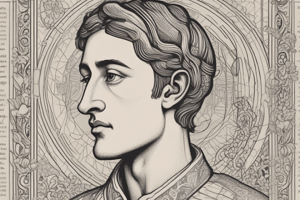Podcast
Questions and Answers
In 'I wake and feel the fell of dark, not day', what is the significance of the phrase "God's most deep decree" in the context of the poem?
In 'I wake and feel the fell of dark, not day', what is the significance of the phrase "God's most deep decree" in the context of the poem?
The phrase "God's most deep decree" suggests that Hopkins feels bound by a divine mandate to endure suffering. This suggests a fatalistic view of his situation, where his pain is predetermined and inescapable.
In 'I wake and feel the fell of dark, not day', explain the significance of the imagery used in the lines "Bones built in me, flesh filled, blood brimmed the curse."
In 'I wake and feel the fell of dark, not day', explain the significance of the imagery used in the lines "Bones built in me, flesh filled, blood brimmed the curse."
The imagery of "bones," "flesh," and "blood" suggests that Hopkins's suffering is deeply ingrained in his very being. The alliteration of "b" sounds emphasizes the pervasive nature of the curse.
In 'I wake and feel the fell of dark, not day', how does Hopkins use the image of bread in the poem to describe his spiritual state?
In 'I wake and feel the fell of dark, not day', how does Hopkins use the image of bread in the poem to describe his spiritual state?
Hopkins uses the image of "selfyeast" turning into a "dull dough" to convey his spiritual stagnation and inability to rise above his despair. This imagery suggests that his spirit is not capable of growth or redemption.
Flashcards are hidden until you start studying
Study Notes
Poem Analysis
- The poem is a Petrarchan sonnet that explores the themes of unrelenting depression, personal suffering, mental health, and the loss of connection to God.
- The poem employs the personal pronoun 'I' and features forceful sound effects, such as alliteration and sibilance, as well as difficult syntax, caesura, and enjambment.
Imagery and Symbolism
- The "fell of dark" in the first line represents the malevolent or darker side of night, creating a foreboding rhythm.
- The "black hours" symbolize the depression the speaker has endured throughout the night.
- The "heart" is addressed as the core of the speaker's being, which has suffered the most.
- The "longer light's delay" represents the drawn-out day ahead.
- The speaker's "cries" are compared to "dead letters sent" to someone who will not respond, conveying the feeling of futility.
Metaphors and Similes
- The speaker feels like they are corroding or becoming "gall", conveying inner suffering.
- The speaker's "taste" is compared to bitter, symbolizing the affliction of suffering.
- The "bones built in me, flesh filled, blood brimmed the curse" uses heavy alliteration to convey the weight of suffering.
- The "selfyeast of spirit" is a metaphor for the speaker's spirit, which is turning sour and unable to rise out of despair.
Tone and Emotion
- The poem conveys a sense of anguish and desperation, with the speaker feeling trapped in their suffering.
- The use of exclamations and hyperbole emphasizes the intensity of the speaker's emotions.
- The poem creates a sense of discomfort and unease, with vivid imagery that evokes a visceral response.
Themes and Ideas
- The poem explores the idea of unrelenting depression and its impact on the speaker's mental health.
- The loss of connection to God is a recurring theme, with the speaker feeling isolated and deprived of redemption.
- The poem highlights the suffering of others, with the speaker recognizing that they are not alone in their affliction.
Studying That Suits You
Use AI to generate personalized quizzes and flashcards to suit your learning preferences.




